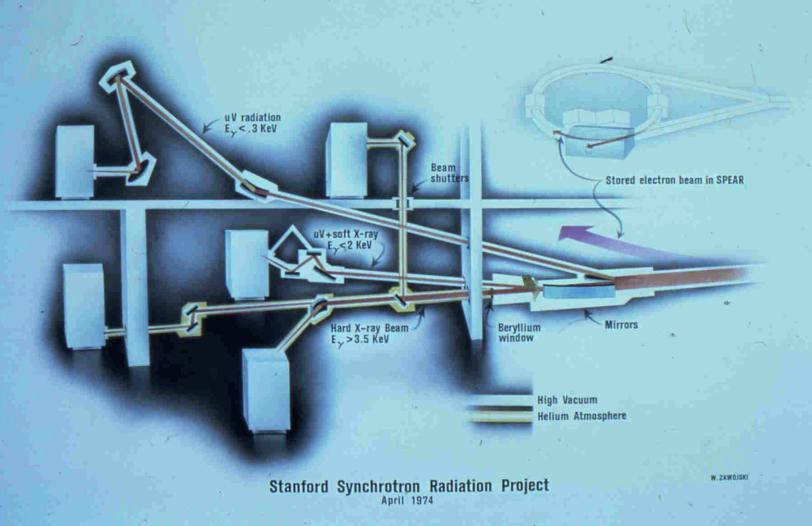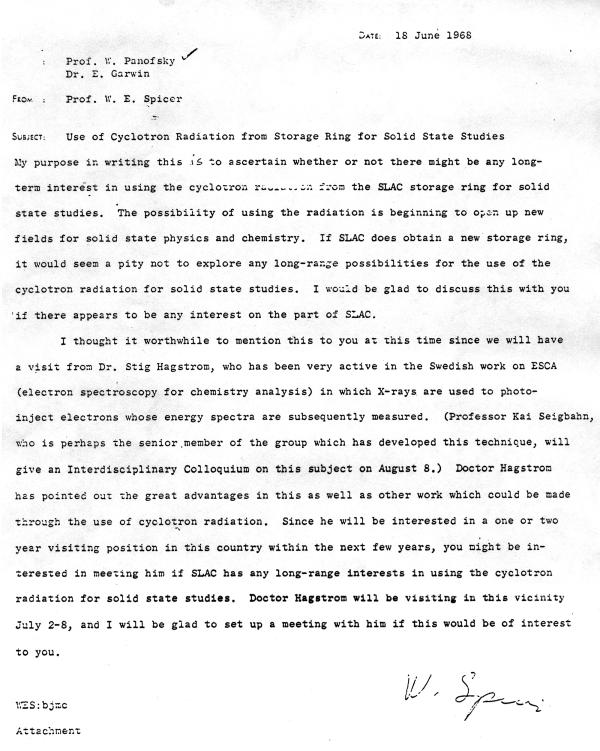Stanford Synchrotron Radiation Project (SSRP)
X-ray science at SLAC began with the Stanford Synchrotron Radiation Project (SSRP). SLAC's SPEAR ring was built with one tangential port to allow synchrotron radiation to come out. Without the foresight of the ring designers to do this, SSRP would probably never have come into existence.
A successful pilot project at SPEAR led to the National Science Foundation funding the SSRP which began operations in May 1974, 8 months ahead of schedule. SSRP was the first synchrotron radiation laboratory on a multi-GeV electron storage ring that was set up as a national facility to provide access to a broad spectral range -- including hard x-rays -- to a large number of users. Although limited by parasitic operation on the SPEAR colliding-beam program, research done at SSRP revolutionized x-ray science, leading to the funding of dedicated multi-GeV facilities in the US and abroad, the so-called second generation light sources
At the start, five experimental stations shared radiation from one bending magnet tangential exit port that was part of the initial construction of the SPEAR colliding-beam storage ring. What is now the Stanford Synchrotron Radiation Lightsource (SSRL) has blossomed from a small adjunct to the SPEAR particle physics program into a vital part of SLAC National Accelerator Laboratory.
Selected Timeline
1968
Bill Spicer (Stanford University) memorandum of June 18, 1968, making a very early request that Pief Panofsky consider the possibility of using "cyclotron" (later called synchrotron) radiation from the planned SLAC storage ring for solid state studies
1972
Decision is made to start a pilot project to use the synchrotron radiation at SPEAR. In January, the Center for Materials Research (CMR) at Stanford provides funds to install an ultra-high vacuum valve on a tangential port. A beryllium window assembly and other front-end components are later added to this tangential port without venting the storage-ring vacuum system. The CMR also funds the design and cost estimate for a one-port three-station facility at SPEAR. A supplementary proposal is submitted to the National Science Foundation in November to cover the costs for the pilot project, which was focused on high-resolution X-ray photoemission spectroscopy. A proposal to build and operate the facility is submitted to the NSF by PI Sebastian Doniach. Another proposal for a synchrotron facility at the Cambridge Electron Accelerator (CEA)is submitted by William Paul, Karl Strauch, and Herman Winick at Harvard University. A review committee established by the NSF makes site visits to both SLAC and the CEA and decides in favor of the SLAC proposal.
1973
Stanford Synchrotron Radiation Project (SSRP) started by Sebastian Doniach (Director) and William Spicer (Consulting Director) with funding from the National Science Foundation; the US Navy’s Michelson Lab at China Lake, California; Xerox Corporation; and Bell Telephone Laboratory. Herman Winick from the CEA joins SSRP as Associate Director.
5/1974
SSRP begins operations (8 months ahead of schedule) with 5 experimental stations sharing a beamline.
10/24-25/1974
First SSRP Users Group meeting
11/1974
The November Revolution takes center stage: On November 8th the first sharp resonance is discovered at SPEAR, beam energy required is 1.5 GeV, no x-ray experiments are possible at this beam energy, UV experiments continue. On November 11th, SSRP is given a prime shift, "experimenters [are] very happy." On November 20th a second sharp resonance is observed, beam energy required is 1.85 GeV, better for SSRP than November 8th, but still not much x-ray flux.
1975
National Science Foundation funds a second main beam line and a general expansion of laboratory facilities at SSRP.
Brian Kinkaid, who played a major role in the development of the SSRP EXAFS facility, completes his Ph.D., the first to be awarded for work done at SSRP.
1976
Cullie Sparks of the Oak Ridge National Laboratory led the team that did the search for superheavy elements at SSRP in 1976. The synchrotron radiation experiments definitively showed that the claims for the presence of superheavy elements in some minerals were inaccurate.
5/1976
A second beam line with 4 additional synchrotron radiation experimental stations begins operating at SPEAR
12/1976
SSRP user community numbers almost 200 scientists from 52 different institutions, with 138 active research proposals. NSF approves SSRP expansion proposal, including new experimental hall, new beam lines, and a wiggler magnet.
4/1977
SSRP Wiggler Workshop: A three-day workshop on the subject of Wiggler magnets is held at SLAC on March 21-23, 1977, and is attended by about 60 scientists from 17 laboratories around the world.
9/1/1977
SSRP becomes Stanford Synchrotron Radiation Laboratory (SSRL)
SSRP Photo Gallery

Sources (in chronological order)
Contemporary
W. E. Spicer letter:

(SLAC AHRO) W. E. Spicer to W. Panofsky and E. Garwin, "Use of Cyclotron Radiation from Storage Ring for Solid State Studies," 6/18/1968 - S. Doniach and H. Winick, Activity Report to National Science Foundation: Period May 1973-December 1974
- Herman Winick and Bill Kirk, "SSRP: Stanford Sychrotron Radiation Project," The SLAC Beam Line, special section, 1/1975
- Herman Winick, "Major Expansion of Facilities for SSRP," The SLAC Beam Line, 7/1975, p.2
- K.O. Hodgson, H. Winick, and G. Chu, Synchrotron Radiation Research and the Stanford Sychrotron Radiation Project: The Experience and Prospects of Using a Multi GeV Storage Ring (SSRP Report No.76/100) 8/1976, Introduction and Chapter IV: Present SSRP Facility
- Synchrotron Radiation Research, SLAC Beamline Special Section, February 1977
- Herman Winick, "SSRP News: The Wiggler Workshop," The SLAC Beam Line, 4/1977, p.3-4
- "SSRP News: SSR'P' Goes to 'L'," The SLAC Beam Line, 8/1977, p.5
Later histories and personal narratives
- Arthur Bienenstock, "Burton Richter and SSRL," presentation at A Celebration Honoring Burton Richter, 1/21/2000 (streaming video)
- John Harris and Herman Winick, "SSRL Report: SPEAR Becomes a Shared Facility,"The SLAC Beam Line, 1-2/1980, p.14-15
- Herman Winick, "SSRL at 20 Years: Some Personal Remembrances of the Early Days," The Stanford Synchrotron Radiation Laboratory Users Newsletter, 10/1993
- Sebastian Doniach, Keith Hodgson, Ingolf Lindau, Piero Pianetta, and Herman Winick, Early Work with Synchrotron Radiation at Stanford. Journal of Synchrotron Radiation (1997) 4, 380-395. Note: This article is from a Special Issue of Journal of Synchrotron Radiation that marked the 50th anniversary of the first observation of synchrotron radiation light.
The Archives also holds: a video of Herman Winick giving an illustrated talk about the history of SSRP/SSRL, including time-lapse footage of the set up of Cullie Sparks' experiment; snapshots of folks at work; and further information about the X-ray science conducted here.
Note: Some links on this page open pdf files, which require the free Acrobat Reader.
